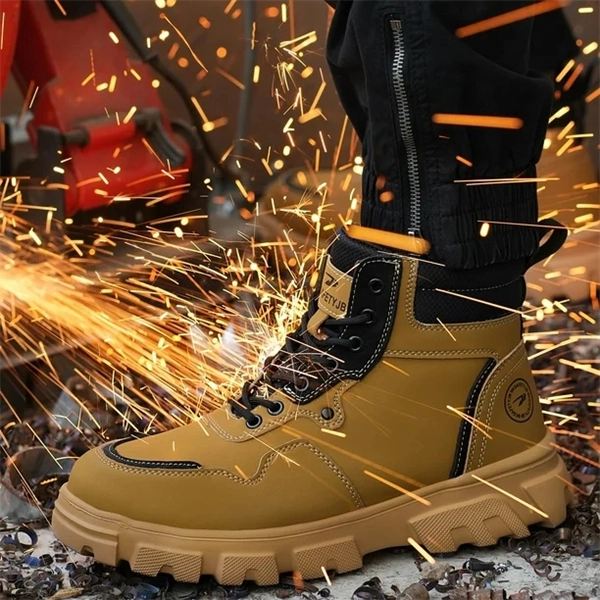
Why I’ll Never Weld Without These Anti-Sparking Cowhide Boots Again: A Journeyman’s Testament
That Tuesday in November changed everything. I was 15 feet up on scaffolding, TIG welding a structural beam when it happened. A shower of molten metal cascaded down, finding every gap in my cheap work boots. Three second-degree burns and eight weeks of recovery later, I learned my lesson the hard way. Safety gear isn’t just another expense—it’s the difference between making it home intact or not.
The Incident That Made Me Rethink Everything
I’d been welding for nearly a decade when it happened. Like many in the trade, I’d gotten comfortable—maybe too comfortable. The steel toe boots I wore were technically “safety rated,” but they were basic, worn out, and frankly, not up to the demands of serious welding work.
That day, I was working on a high-rise project downtown. The awkward angle meant I couldn’t position my body to shield my feet from the inevitable shower of sparks. One particularly aggressive stream found its way between my pant leg and boot collar. The pain was immediate and intense.
“Hey, you okay up there?” my site supervisor called up after hearing my less-than-professional language echo through the construction site.
I wasn’t okay. And I wouldn’t be okay for two months.
The Search for Something Better
During my recovery, I became obsessed with finding boots that could have prevented this. I scoured forums where fellow welders (the guys who don’t sugar-coat anything) discussed their gear. I read OSHA incident reports. I even reached out to my old welding instructor from tech school.
That’s when I discovered these steel toe work boots with anti-sparking cowhide leather. They weren’t just another pair of safety shoes—they were purpose-built for environments exactly like mine.
What Makes These Boots Different: The Technical Breakdown
After returning to work, I invested in these boots and immediately noticed the difference. Here’s what sets them apart:
| Feature | Specification | Real-World Benefit |
|---|---|---|
| Steel Toe Protection | Meets European Standards, withstands 200±4 J | Saved my toes when a 3-inch steel pipe rolled off a workbench |
| Kevlar Midsole | Puncture-resistant | Walked across a debris field with exposed rebar without a second thought |
| Water-Resistant Leather | Premium cowhide upper | Kept my feet dry during a 12-hour shift in unexpected rain |
| Anti-Slip Outsole | Specialized rubber texture | Maintained grip on oil-slicked shop floors |
| Anti-Sparking Design | Cowhide leather construction | No more burn scars from molten metal |
First Week Test: The Burning Question
My first week back on the job became an unintentional test of these boots’ capabilities. I was assigned to a particularly spark-heavy cutting job that involved slicing through old steel beams with an oxy-acetylene torch.
Sparks rained down continuously. My old boots would have been peppered with burn marks—or worse, allowed those sparks to find my skin. These new boots? The sparks literally bounced off the cowhide leather without leaving a mark.
At the end of that first week, my foreman noticed something different about me. “You’re not dancing around like you usually do when you’re cutting,” he observed.
He was right. I wasn’t constantly shifting my feet to avoid sparks. I was stable, focused, and working more efficiently than I had in years.
The Comfort Factor: Not Just Safe, But Sustainable
Safety is non-negotiable in welding work, but comfort determines whether you can actually wear your PPE for a full shift. These boots surprised me here too.
The padded top collar that initially seemed like a marketing gimmick turned out to be a game-changer during 10-hour shifts. My previous boots would leave angry red marks around my ankles by day’s end. These didn’t.
The “lightweight” claim also held up. According to my bathroom scale (not exactly NIST-calibrated, but close enough), each boot weighs about 20% less than my previous steel toes. When you’re on your feet all day, that difference is significant.
Six Months Later: The Durability Test
Any welder will tell you: our gear takes a beating. After six months of daily use in everything from fabrication shops to outdoor construction sites, here’s how these boots have held up:
- The cowhide leather has developed a patina but shows no signs of cracking or excessive wear
- The steel toe is still firmly in place, with no separation from the upper
- The anti-slip soles have maintained their grip pattern, even in high-wear areas
- The waterproofing still works (tested thoroughly during an unexpected downpour at an outdoor site)
- The laces have been replaced once (fair enough—I’m rough on laces)
Beyond Welding: Versatility in the Field
While my primary concern was finding boots that could handle welding environments, I’ve discovered their versatility extends far beyond. Over the past year, I’ve worn these boots:
- During a two-week stint helping with concrete formwork
- While operating heavy machinery at a demolition site
- Through a three-day industrial electrical installation
- During weekend woodworking projects in my garage
In each scenario, the boots performed admirably. The anti-slip properties were particularly noticeable when moving between indoor and outdoor environments, where changing surface conditions can create hazards.
The Investment Calculation
Let’s talk money. These boots cost me about $30 more than my previous “budget” safety footwear. But when I factor in:
- Two months of lost wages during recovery
- Medical bills from burn treatment
- The extended lifespan of these boots compared to cheaper alternatives
It’s not even close. These boots have already paid for themselves several times over.
As my grandfather (a 40-year ironworker) used to say: “You can’t afford cheap tools when your safety’s on the line.”
What My Colleagues Are Saying
I’m not the only convert. After seeing my new boots in action, three of my coworkers made the switch. Our newest apprentice, Jesse, was particularly impressed.
“I was gonna go with the cheap ones from the big box store,” he told me during lunch break. “Seeing those sparks bounce off your boots changed my mind. Worth every penny.”
Our site safety officer, Marion (who’s seen more workplace injuries than anyone should have to), has started recommending these specific boots during safety briefings. That’s about as strong an endorsement as you can get in this industry.
FAQ: What You Need to Know About These Welding Boots
How long is the break-in period?
Unlike traditional leather work boots that can take weeks to break in, these were comfortable after about 3-4 days of regular wear. The padded collar helps reduce friction during the break-in period.
Do they work in extreme temperatures?
I’ve worn these in Chicago winters (-15°F) and summer heat (95°F+). The leather breathes well enough to prevent excessive sweating in heat, while providing adequate insulation in cold when paired with proper socks.
How do they handle electrical hazards?
While not explicitly marketed as EH-rated (Electrical Hazard), the rubber outsoles have provided adequate insulation during incidental contact with electrical sources. However, for dedicated electrical work, I’d recommend boots specifically rated for electrical hazards.
What’s the best way to maintain the anti-sparking properties?
Clean the leather regularly with a damp cloth and apply a silicone-free leather conditioner quarterly. Avoid petroleum-based products as they can compromise the leather’s natural spark resistance.
Can women wear these boots comfortably?
Several women on our crew wear these boots. They typically order 1.5 sizes down from their normal men’s size equivalent. The lace-up design allows for adjustments to accommodate different foot widths.
Why PPE Matters: A Personal Reflection
When I first started welding, I had a cavalier attitude toward safety gear. It was hot, sometimes uncomfortable, and in my youthful arrogance, I thought injuries happened to “other people.”
That changed after my accident. Now I understand that PPE isn’t just about compliance or avoiding citations—it’s about sustainability in a physically demanding career.
These boots have become an essential part of my daily kit, alongside my auto-darkening helmet and FR jacket. They’re not just equipment; they’re tools that allow me to focus on my craft without worrying about preventable injuries.
The Bottom Line: Protection That Performs
After nearly 18 months of daily use in some of the harshest industrial environments, I can confidently say these steel toe work boots have transformed my approach to safety and comfort on the job.
The combination of anti-sparking cowhide leather, proper steel toe protection, puncture-resistant Kevlar midsole, and thoughtful design features like the padded collar and lightweight construction make these boots stand out in a crowded field of safety footwear.
Whether you’re a seasoned welder, a construction professional, or just starting your apprenticeship, these boots deserve serious consideration. Your feet carry you through every workday—they deserve the best protection available.
Don’t wait for an accident to upgrade your safety gear. Take it from someone who learned the hard way: invest in proper protection now, and focus on your craft without compromise. 🔥👷♂️
Ready to upgrade your safety footwear? Check out these Steel Toe Work Boots and experience the perfect balance of protection and comfort that’s changing how professionals approach workplace safety.
About the author: Mike Ramirez is a certified CWI (Certified Welding Inspector) with 12 years of field experience in structural and industrial welding. He currently works as a lead welder for a major construction company in the Midwest and conducts safety workshops for apprentice welders.
